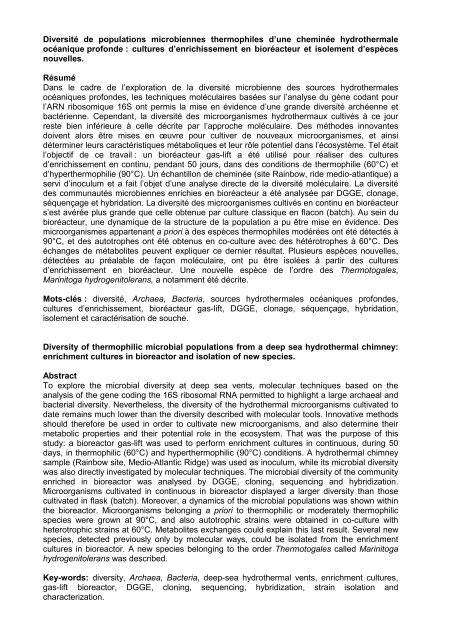THESE Anne POSTEC Diversité de populations microbiennes ...
THESE Anne POSTEC Diversité de populations microbiennes ...
THESE Anne POSTEC Diversité de populations microbiennes ...
You also want an ePaper? Increase the reach of your titles
YUMPU automatically turns print PDFs into web optimized ePapers that Google loves.
Diversité <strong>de</strong> <strong>populations</strong> <strong>microbiennes</strong> thermophiles d’une cheminée hydrothermale<br />
océanique profon<strong>de</strong> : cultures d’enrichissement en bioréacteur et isolement d’espèces<br />
nouvelles.<br />
Résumé<br />
Dans le cadre <strong>de</strong> l’exploration <strong>de</strong> la diversité microbienne <strong>de</strong>s sources hydrothermales<br />
océaniques profon<strong>de</strong>s, les techniques moléculaires basées sur l’analyse du gène codant pour<br />
l’ARN ribosomique 16S ont permis la mise en évi<strong>de</strong>nce d’une gran<strong>de</strong> diversité archéenne et<br />
bactérienne. Cependant, la diversité <strong>de</strong>s microorganismes hydrothermaux cultivés à ce jour<br />
reste bien inférieure à celle décrite par l’approche moléculaire. Des métho<strong>de</strong>s innovantes<br />
doivent alors être mises en œuvre pour cultiver <strong>de</strong> nouveaux microorganismes, et ainsi<br />
déterminer leurs caractéristiques métaboliques et leur rôle potentiel dans l’écosystème. Tel était<br />
l’objectif <strong>de</strong> ce travail : un bioréacteur gas-lift a été utilisé pour réaliser <strong>de</strong>s cultures<br />
d’enrichissement en continu, pendant 50 jours, dans <strong>de</strong>s conditions <strong>de</strong> thermophilie (60°C) et<br />
d’hyperthermophilie (90°C). Un échantillon <strong>de</strong> cheminée (site Rainbow, ri<strong>de</strong> medio-atlantique) a<br />
servi d’inoculum et a fait l’objet d’une analyse directe <strong>de</strong> la diversité moléculaire. La diversité<br />
<strong>de</strong>s communautés <strong>microbiennes</strong> enrichies en bioréacteur a été analysée par DGGE, clonage,<br />
séquençage et hybridation. La diversité <strong>de</strong>s microorganismes cultivés en continu en bioréacteur<br />
s’est avérée plus gran<strong>de</strong> que celle obtenue par culture classique en flacon (batch). Au sein du<br />
bioréacteur, une dynamique <strong>de</strong> la structure <strong>de</strong> la population a pu être mise en évi<strong>de</strong>nce. Des<br />
microorganismes appartenant a priori à <strong>de</strong>s espèces thermophiles modérées ont été détectés à<br />
90°C, et <strong>de</strong>s autotrophes ont été obtenus en co-culture avec <strong>de</strong>s hétérotrophes à 60°C. Des<br />
échanges <strong>de</strong> métabolites peuvent expliquer ce <strong>de</strong>rnier résultat. Plusieurs espèces nouvelles,<br />
détectées au préalable <strong>de</strong> façon moléculaire, ont pu être isolées à partir <strong>de</strong>s cultures<br />
d’enrichissement en bioréacteur. Une nouvelle espèce <strong>de</strong> l’ordre <strong>de</strong>s Thermotogales,<br />
Marinitoga hydrogenitolerans, a notamment été décrite.<br />
Mots-clés : diversité, Archaea, Bacteria, sources hydrothermales océaniques profon<strong>de</strong>s,<br />
cultures d’enrichissement, bioréacteur gas-lift, DGGE, clonage, séquençage, hybridation,<br />
isolement et caractérisation <strong>de</strong> souche.<br />
Diversity of thermophilic microbial <strong>populations</strong> from a <strong>de</strong>ep sea hydrothermal chimney:<br />
enrichment cultures in bioreactor and isolation of new species.<br />
Abstract<br />
To explore the microbial diversity at <strong>de</strong>ep sea vents, molecular techniques based on the<br />
analysis of the gene coding the 16S ribosomal RNA permitted to highlight a large archaeal and<br />
bacterial diversity. Nevertheless, the diversity of the hydrothermal microorganisms cultivated to<br />
date remains much lower than the diversity <strong>de</strong>scribed with molecular tools. Innovative methods<br />
should therefore be used in or<strong>de</strong>r to cultivate new microorganisms, and also <strong>de</strong>termine their<br />
metabolic properties and their potential role in the ecosystem. That was the purpose of this<br />
study: a bioreactor gas-lift was used to perform enrichment cultures in continuous, during 50<br />
days, in thermophilic (60°C) and hyperthermophilic (90°C) conditions. A hydrothermal chimney<br />
sample (Rainbow site, Medio-Atlantic Ridge) was used as inoculum, while its microbial diversity<br />
was also directly investigated by molecular techniques. The microbial diversity of the community<br />
enriched in bioreactor was analysed by DGGE, cloning, sequencing and hybridization.<br />
Microorganisms cultivated in continuous in bioreactor displayed a larger diversity than those<br />
cultivated in flask (batch). Moreover, a dynamics of the microbial <strong>populations</strong> was shown within<br />
the bioreactor. Microorganisms belonging a priori to thermophilic or mo<strong>de</strong>rately thermophilic<br />
species were grown at 90°C, and also autotrophic strains were obtained in co-culture with<br />
heterotrophic strains at 60°C. Metabolites exchanges could explain this last result. Several new<br />
species, <strong>de</strong>tected previously only by molecular ways, could be isolated from the enrichment<br />
cultures in bioreactor. A new species belonging to the or<strong>de</strong>r Thermotogales called Marinitoga<br />
hydrogenitolerans was <strong>de</strong>scribed.<br />
Key-words: diversity, Archaea, Bacteria, <strong>de</strong>ep-sea hydrothermal vents, enrichment cultures,<br />
gas-lift bioreactor, DGGE, cloning, sequencing, hybridization, strain isolation and<br />
characterization.
















